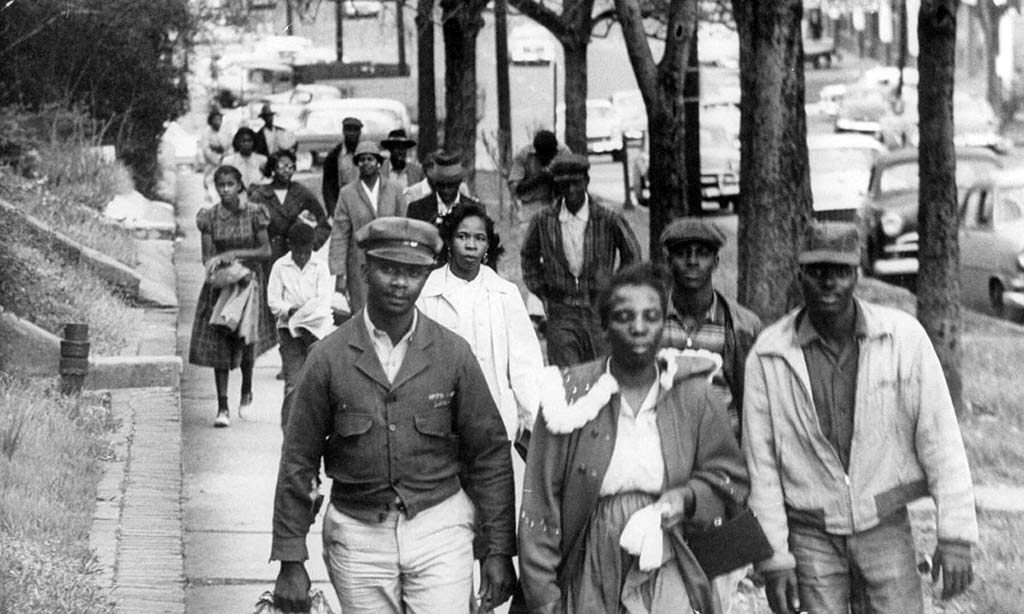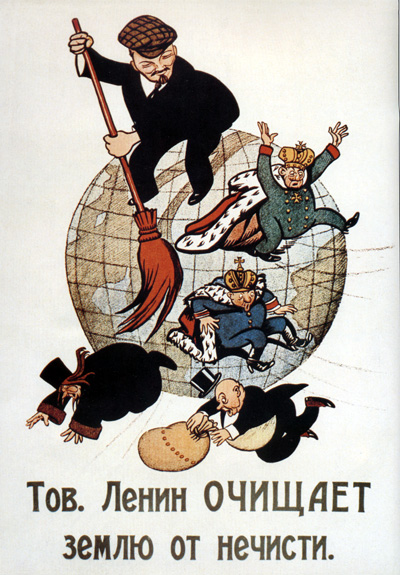The Montgomery Bus Boycott in Montgomery, Alabama was a crucial event in the 20th Century Civil Rights Movement. On the evening of December 1, 1955 Rosa Parks, a Montgomery seamstress on her way home from work, refused to give up her seat on the bus for a white man and was subsequently arrested. The President of the local chapter of the National Association for the Advancement of Colored People (NAACP), E.D. Nixon, used the arrest to launch a bus boycott to fight the city’s segregated bus policy. Together with Jo Ann Robinson of the Women’s Political Council, and other black leaders, Nixon set plans for the boycott.
The idea of the boycott had been floating around for months. Both Nixon and Robinson were waiting for a test cast to challenge the segregated bus policy in Court. They knew that they would have large support from black women who made up a majority of the bus users. The only thing missing was a good test candidate and respectable, middle-class Rosa Parks seemed perfect for the role.
On Friday December 2, Robinson created a flyer which she distributed to black families around Montgomery. The flyer told of the arrest of Parks and mentioned that 75% of the bus riders were blacks and if there was a boycott of the bus system then the city would be forced to pay attention to these customers. It then called for a boycott of the buses on Monday December 5th.
Robinson arranged a meeting with Rev. Ralph Abernathy and Rev. Martin Luther King Jr., the ministers of two of the largest black churches in the city. While they hesitated at first, they ultimately agreed to participate and held a meeting at the Dexter Avenue Baptist Church, King’s church, to plan the boycott. A new organization, the Montgomery Improvement Association (MIA), was created to lead the boycott and Rev. King was appointed its president. It was also decided that the boycott should continue until the buses were no longer segregated. In order to get people around town during the boycott, the churches bought or rented cars and station wagons to transport people.
Meanwhile boycott supporters challenged the legality of bus segregation in court. Their case, Browder v. Gayle, was eventually heard by the U.S. Supreme Court which ruled on November 13, 1956, in favor of the plaintiffs. The boycott ended on December 20, 1956, 381 days after it had begun. The buses in Montgomery were now integrated.
Megathreads and spaces to hang out:
- ❤️ Come listen to music and Watch movies with your fellow Hexbears nerd, in Cy.tube
- 💖 Come talk in the New Weekly Queer thread
- 💛 Read and talk about a current topics in the News Megathread
- 💚 Come and talk in the Daily Bloomer Thread
- ⭐️ September Movie Nominations ⭐️
reminders:
- 💚 You nerds can join specific comms to see posts about all sorts of topics
- 💙 Hexbear’s algorithm prioritizes comments over upbears
- 💜 Sorting by new you nerd
- 🌈 If you ever want to make your own megathread, you can reserve a spot here nerd
- 🐶 Join the unofficial Hexbear-adjacent Mastodon instance toots.matapacos.dog
Links To Resources (Aid and Theory):
Aid:
Theory:


I'm still trying to figure out how anyone thought the instant-death/quick-death stealth genre was a good fit for the Metroid series. I'm on board with experimentation in games, of course. Otherwise you just get prettier versions of the exact same old thing for decades. But Metroid's appeal is about making the player feel like an unstoppable badass hero, laying waste to villains and saving the galaxy. If I wanted to play an insomnia-curing stealth game where I feel like a helpless victim in a 1980s slasher movie fleeing for my life, I'd just go play a Metal Gear sequel.
I've always found it a little disturbing that the Japanese-developed Metroid games post-Super were all about making Samus seem like a helpless little girl in the face of danger, hiding in vents and using cloaking devices and moving really slowly and rarely shooting anything because that would draw the attention of stronger foes that scare her.
Meanwhile the American-developed Prime series was all about making Samus the baddest motherfucker in the universe. She cannot be stopped. There are no stronger foes. Samus arrives in a room full of space pirates, and the question is not "will she survive?", the question is "how long will it take for her to mop the floor with everyone else in the room?" And that's emphasized with hilarious scannable computer logs of Samus' foes describing their fear in the face of the unstoppable rampage of the terror they call "the Hunter".
I don't wanna crawl around in vents being quiet and getting one-shotted. I wanna make villains shit their pants upon learning of my arrival.
When I think of "metroidvenia" I think of going from being scared and sneaking to being the strongest thing in the room. I'd postulate the highest form of Metroid would be a fusion (hehe) that goes from Dread to Prime with an anticlimactic end boss who isn't difficult unless you self impose a no hit challenge.
The parts in Fusion where you had to briefly run and hide from the SA-X were pretty fun, because they were brief and took up a small portion of the total runtime, and because they weren't instant death.
Similarly, the sequence toward the end of Zero Mission where you lose your suit and have to sneak around the pirate base was not bad because you knew that as soon as you got your suit back you'd get to come back through and annihilate the pirates, and because it wasn't instant death.
A little bit of stealth in a Metroid game is fine as long as a) it's not most of the game and b) it's not instant death. Dread fails on both counts.
I think you definitely do have a point about the Japanese vs American devs' portrayal of Samus.
As with a lot of nerds, I used to be big into Japanese entertainment of various types. But in the last decade-plus I've been a lot more critical of it all, especially with regards to the rampant misogyny and homophobia and sexualization of minors. I still keep an eye out for work by people that have historically been good at making interesting media. And there's some classic movies/TV series/OVA series that I'll re-watch that has aged well, like Serial Experiments Lain or Dirty Pair. But I've mostly checked out of the whole scene.
And yes, I think Dirty Pair has aged very well. This is not a bit. A lot of people seem to think of the franchise's signature revealing outfits and haven't seen it recently (or at all), so they think it's only about sleazy objectification. But Kei and Yuri are adult women, with professional competency, personal agency, and reasonably-well-developed morality. And they were being top-tier trans-rights allies in 1985.. They just weren't lucky.
I found a YouTube link in your comment. Here are links to the same video on alternative frontends that protect your privacy: